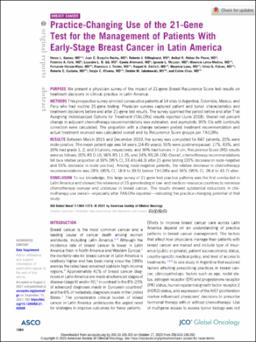| dc.description.abstract | Abstract
Purpose: We present a physician survey of the impact of 21-gene Breast Recurrence Score test results on treatment decisions in clinical practice in Latin America.
Methods: This prospective survey enrolled consecutive patients at 14 sites in Argentina, Colombia, Mexico, and Peru who had routine 21-gene testing. Physician surveys captured patient and tumor characteristics and treatment decisions before and after 21-gene test results. The survey spanned the period before and after Trial Assigning Individualized Options for Treatment (TAILORx) results reported (June 2018). Overall net percent change in adjuvant chemotherapy recommendations was estimated, and asymptotic 95% CIs with continuity correction were calculated. The proportion with a change between pretest treatment recommendation and actual treatment received was calculated overall and by Recurrence Score groups per TAILORx.
Results: Between March 2015 and December 2019, the survey was completed for 647 patients; 20% were node-positive. The mean patient age was 54 years (24-85 years); 55% were postmenopausal; 17%, 63%, and 20% had grade 1, 2, and 3 tumors, respectively; and 30% had tumors > 2 cm. Recurrence Score (RS) results were as follows: 20% RS 0-10, 56% RS 11-25, and 24% RS 26-100. Overall, chemotherapy recommendations fell by a relative proportion of 39% (95% CI, 33.4 to 44.3) after 21-gene testing (33% decrease in node-negative and 55% decrease in node-positive). Among node-negative patients, the relative decrease in chemotherapy recommendations was 28% (95% CI, 18.9 to 39.5) before TAILORx and 36% (95% CI, 28.4 to 43.7) after.
Conclusion: To our knowledge, this large survey of 21-gene test practice patterns was the first conducted in Latin America and showed the relevance of 21-gene testing in low- and medium-resource countries to minimize chemotherapy overuse and underuse in breast cancer. The results showed substantial reductions in chemotherapy use overall-especially after TAILORx reported-indicating the practice-changing potential of that study. | es |


